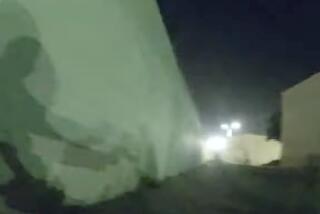San Bernardino County sheriff details final shootout with Dorner
- Share via
Fugitive Christopher Dorner spent his final hours barricaded inside a mountain cabin armed with a high-powered sniper rifle, smoke bombs and a cache of ammo, shooting to kill and ignoring commands to surrender until a single gunshot ended his life, authorities said Friday.
The evidence indicates that Dorner, a fired Los Angeles police officer suspected of killing four people and wounding three others, held a gun to his head and fired while the Big Bear area cabin he was holed up in caught fire, ignited by police tear gas.
San Bernardino County Sheriff John McMahon, during a news conference Friday, offered the most detailed account yet of the manhunt and final shootout, which left one of his deputies dead and another seriously wounded. McMahon steadfastly defended the tactics used by his agency, dismissing assertions that deputies may have botched the hunt for Dorner or deliberately set the cabin on fire.
FULL COVERAGE: The manhunt for a former LAPD officer
“We stand confident in our actions on that fateful day,” he said. “The bottom line is the deputy sheriffs of this department, and the law enforcement officers from the surrounding area, did an outstanding job. They ran into the line of fire. They were being shot at, and didn’t turn around in retreat.”
During Tuesday’s shootout, a television news crew recorded law enforcement officials shouting to burn the cabin down. McMahon acknowledged the comments were made, but said they did not come from the department’s tactical team or commanders on the scene.
“They had just been involved in probably one most of the most fierce firefights,” he said of the people heard on the recording. “And sometimes, because we’re humans, we say things that may or may not be appropriate. We will look into this and we will deal it appropriately.”
The blaze started shortly after police fired “pyrotechnic” tear gas into the cabin; the canisters are known as “burners” because the intense heat they emit often causes a fire.
Sheriff’s Capt. Gregg Herbert, who led the assault on the cabin, said the canisters were used only as a last resort after Dorner continued firing at deputies, ignored commands to surrender and did not respond when “cold,” less intense tear gas was shot into the wood-framed dwelling.
Herbert said that a tractor was deployed to tear down walls of the cabin to expose Dorner’s whereabouts inside, but that Dorner set off smoke bombs to hide himself. Storming the cabin was considered too dangerous because of the belief that Dorner “was lying in wait for us,” he said.
“This was our only option,” Herbert said of the pyrotechnic tear gas, adding that the potential for igniting a fire was taken into account.
After about a quarter of the cabin was engulfed in flames, Herbert said, “we heard a distinct single gunshot” come from inside. The shot sounded different from those Dorner had fired at deputies, indicating a different type of weapon was used, he said.
Dental records were used to confirm that the remains found in the cabin were indeed those of Dorner, 33.
FULL COVERAGE: The manhunt for a former LAPD officer
The Riverside County coroner’s office conducted an autopsy on Dorner, and determined that his death was caused by a single gunshot to the head. The coroner has not positively determined that Dorner shot himself, but the evidence “seems to indicate that the wound … was self inflicted,” said Capt. Kevin Lacy of the San Bernardino County coroner’s division.
From the cabin and vehicles Dorner used in the San Bernardino Mountains, investigators recovered a cache of weapons and ammunition. Among them: numerous assault weapons — including a bolt-action .308 caliber sniper’s rifle — silencers, handguns, high-capacity magazines, smoke bombs, tear gas and a military-style Kevlar helmet.
McMahon said it was unclear how Dorner was able to carry all those weapons while on foot and on the run in Big Bear. But he said there’s no evidence Dorner had an accomplice or received aid from anyone.
During Friday’s news conference, McMahon also was pressed to address the anger and frustration of Big Bear residents who questioned how Dorner was able to hide out undetected for five days. In fact, Dorner was hiding in a vacation rental condominium less than 200 yards from law enforcement’s command center during the manhunt.
The sheriff said the condo had been checked early in the search. The door was locked and no one answered when deputies knocked. Since there was no sign of forced entry on the door or windows, the deputies moved on.
McMahon said the decision was made not to kick open doors of unoccupied homes because they had no search warrants, and doing so would have included “hundreds” of homes — since many of the cabins and homes are unoccupied vacation homes.
Investigators later learned that the owners of the condo, Jim and Karen Reynolds, had left the unit unlocked to allow workers inside. When the Reynoldses entered the condo Tuesday morning, Dorner tied them up and stole their car. One of them was able to break free and call 911, leading to the deadly standoff at the mountain cabin in Angelus Oaks.
“I don’t believe we made any mistakes,” McMahon said.
According to an online manifesto that authorities say Dorner posted to his Facebook page, the killing rampage was in retaliation for his firing from the Los Angeles Police Department in 2009.
His first alleged victims, a young Irvine couple, were probably stalked before being shot multiple times with a 9-millimeter pistol equipped with a high-capacity magazine, according to an affidavit for a search warrant.
Monica Quan, 28, and Keith Lawrence, 27, were found dead on the top floor of their condominium’s parking garage on Feb. 3. Quan’s father — a former LAPD captain — represented Dorner at a disciplinary hearing that led to his firing.
FULL COVERAGE: The manhunt for a former LAPD officer
Two days later, police in National City discovered in a trash bin leather duty gear, uniforms with name tags for Dorner and a high-capacity magazine for 9-millimeter bullets that were believed to have belonged to Dorner, according to the affidavit. Surveillance video appears to show Dorner discarding the items in the trash bin.
Authorities say that in the early morning hours of Feb. 7, Dorner exchanged gunfire with police in Corona who were protecting an LAPD official believed to have been one of his targets. About 20 minutes later, Dorner opened fire on two Riverside police officers stopped at a red light, killing one and seriously wounding the other. Dorner’s burning, abandoned pickup was found in Big Bear about 9 a.m. that same morning.
On Friday, the sister of the owner of the Angelus Oaks cabin returned to the ash-strewn site to try to make sense of the violence at what was once a cherished mountain retreat for family and friends.
“We came to see if the old place was completely gone — and it is,” said Cindy Moore, 65. “Yet it still means something to the family. It was filled with artifacts and photographs, some 80 years old, that cannot be replaced.”
She nodded toward a 10-foot-deep section of the property filled with charred debris and green latex gloves discarded by forensic investigators
“They say Dorner died in the basement over there.”
More to Read
Sign up for Essential California
The most important California stories and recommendations in your inbox every morning.
You may occasionally receive promotional content from the Los Angeles Times.













